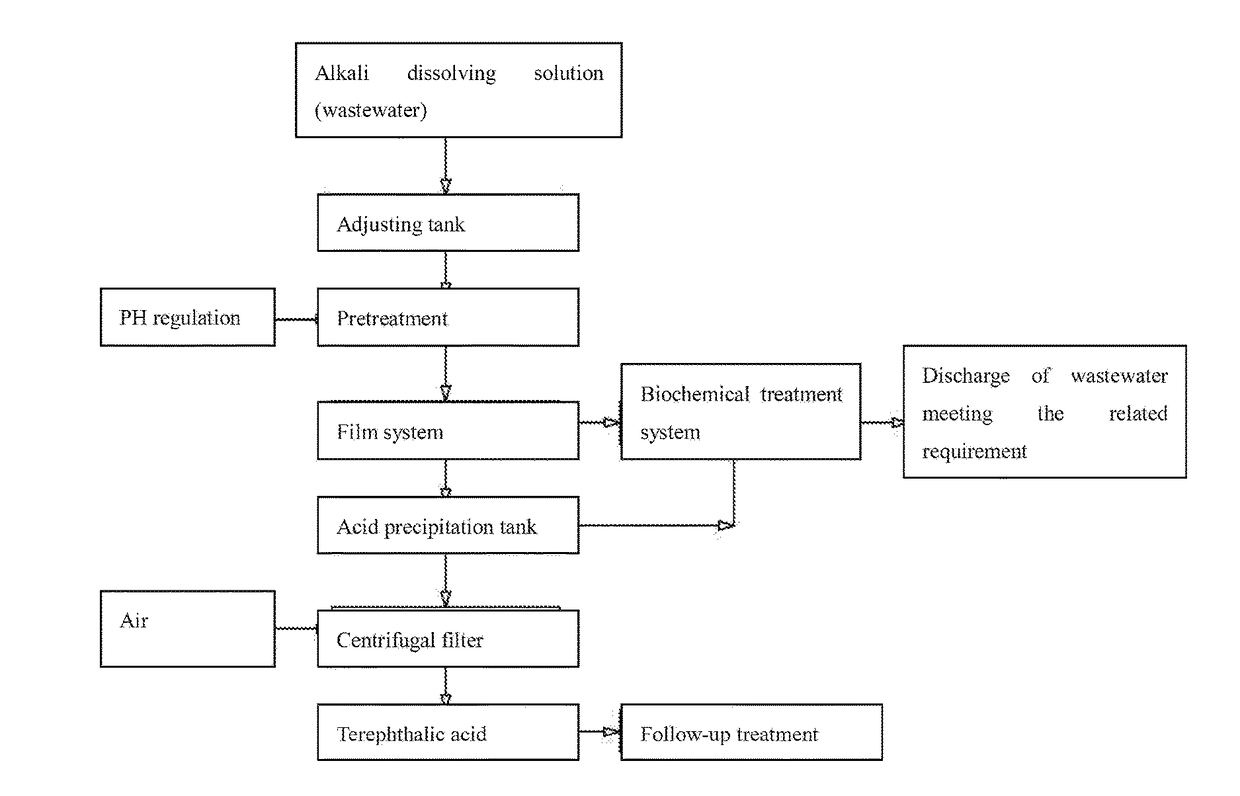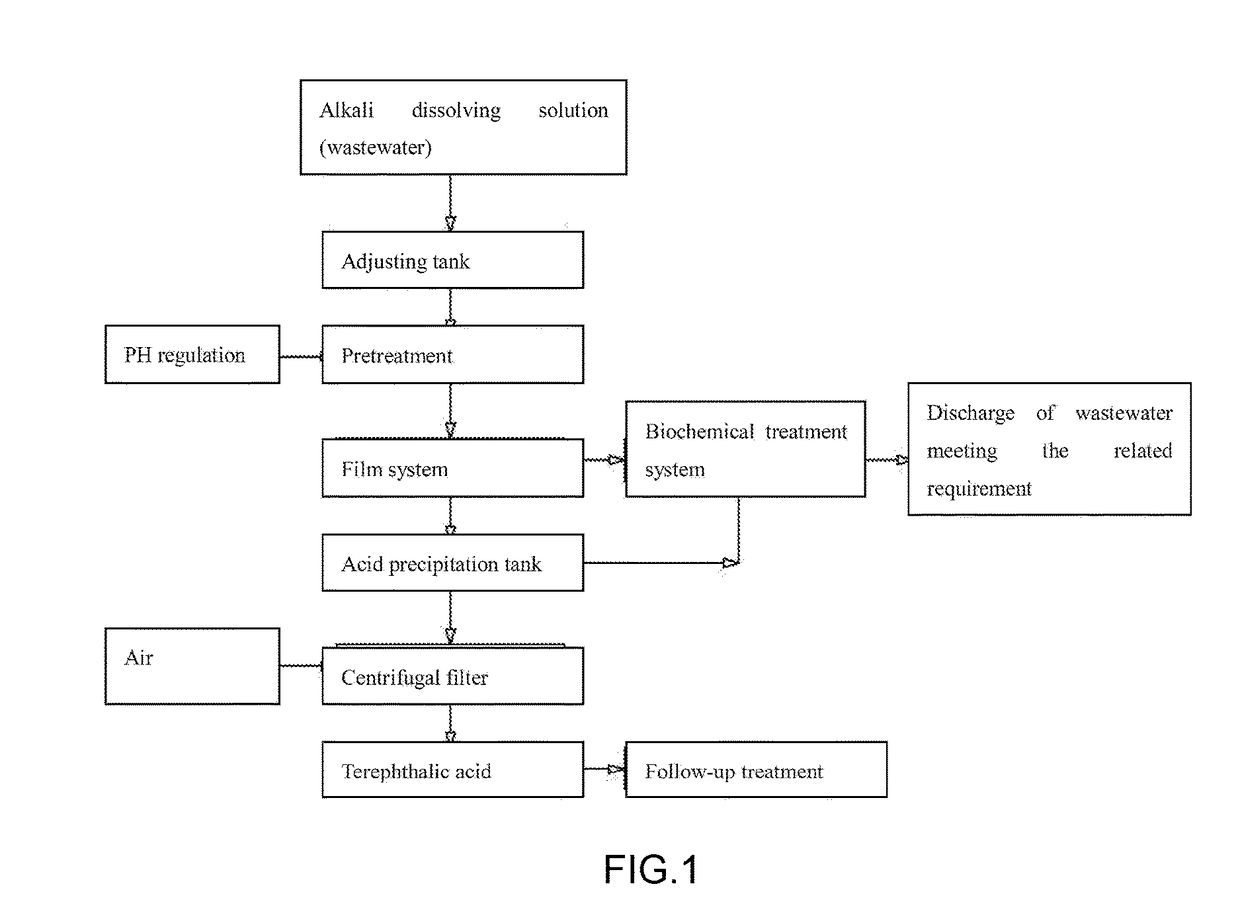Technology for Recovery, Regeneration and Reuse of Soluble Textiles
a technology for soluble textiles and textiles, applied in the field of fibre processing, textile processing and environmental technology, can solve the problems of no technology or product for simply treating, low value in use, and waste of resources, and achieve the effects of reducing environmental pollution, ensuring spinnability and wearing performance, and reducing environmental pollution
- Summary
- Abstract
- Description
- Claims
- Application Information
AI Technical Summary
Benefits of technology
Problems solved by technology
Method used
Image
Examples
embodiment 1
[0041, the technology for the dissolution, recovery and reuse of the fabrics and soluble apparel accessories containing 100% dissolution-controlled soluble fibres, comprises the following processing steps:
[0042]a. During the polymerization of the polyester raw materials, 5-sodiumsulfonate-isophthalic acid polyglycol ester by weight of 6% of the total weight of polymer and isophthalic acid by weight of 4% of the total weight of polymer were added, pulped and agitated, meanwhile heated to 230° C., then the mixture was transferred to a reaction kettle and polyethylene glycol by weight of 10% of the total weight of polymer was added to dilute and cool the mixture to 210° C., additional polyethylene glycol by weight of 10% of the total weight of polymer was added to the reaction kettle continuously within 50 minutes with agitating, the temperature was increased to 230° C. under atmospheric pressure and the mixture polymerized under vacuum, the alkaline degradation slices with intrinsic v...
embodiment 2
[0049, the technology for the dissolution, recovery and reuse of fibre fabrics and soluble apparel accessories of blended yarn fabric consisting of dissolution-controlled soluble fibres and cellulose fibres, comprises the following steps:
[0050]a. The dissolution-controlled soluble staple fibres made in Embodiment 1 were blended with the cellulose fibres such as cotton, hemp and artificial fibre, with blending ratios of 65 / 35, 50 / 50, etc.; the yarn count was based on the specification of conventional cellulose fibres or blended yarn; the weaving was performed according to conventional process; and the active dye and dispersive dye dyeing processes of polyester and cellulose fibres two-bath process were adopted in the dyeing process, thereby making the fabrics including tatted fabrics and knitted fabrics;
[0051]1. The sewing threads of the textiles can be prepared by the above blended yarn of the staple fibres after being twisted;
[0052]2. The above ready-made garments and textiles are ...
embodiment 3
[0056, the technology for the dissolution, recovery and reuse of fibre fabrics and soluble apparel accessories of blended yarn fabric consisting of dissolution-controlled soluble fibres and cellulose fibres in addition with spandex fibre textiles, comprises the following steps:
[0057]a. Staple fibres with 38 mm of length, 1.5D of fineness, 3.6 cn / tex of strength and 25% of break elongation were made of polymerized raw materials from Embodiment 1 by conventional spinning process, and the dissolution-controlled soluble staple fibres were blended with cellulose fibres (such as cotton, hemp and artificial fibres, with the blending ratios of 65 / 35, 50 / 50 and the like, and the yarn obtained was interwoven with spandex or twisted with elastic yarn, and tatted or knitted fabrics were made by conventional weaving process; and the active dye and dispersive dye dyeing processes of polyester and cellulose fibres two-bath process were adopted in the dyeing process, thereby making the fabrics incl...
PUM
| Property | Measurement | Unit |
|---|---|---|
| temperature | aaaaa | aaaaa |
| temperature | aaaaa | aaaaa |
| temperature | aaaaa | aaaaa |
Abstract
Description
Claims
Application Information
 Login to View More
Login to View More - R&D
- Intellectual Property
- Life Sciences
- Materials
- Tech Scout
- Unparalleled Data Quality
- Higher Quality Content
- 60% Fewer Hallucinations
Browse by: Latest US Patents, China's latest patents, Technical Efficacy Thesaurus, Application Domain, Technology Topic, Popular Technical Reports.
© 2025 PatSnap. All rights reserved.Legal|Privacy policy|Modern Slavery Act Transparency Statement|Sitemap|About US| Contact US: help@patsnap.com


